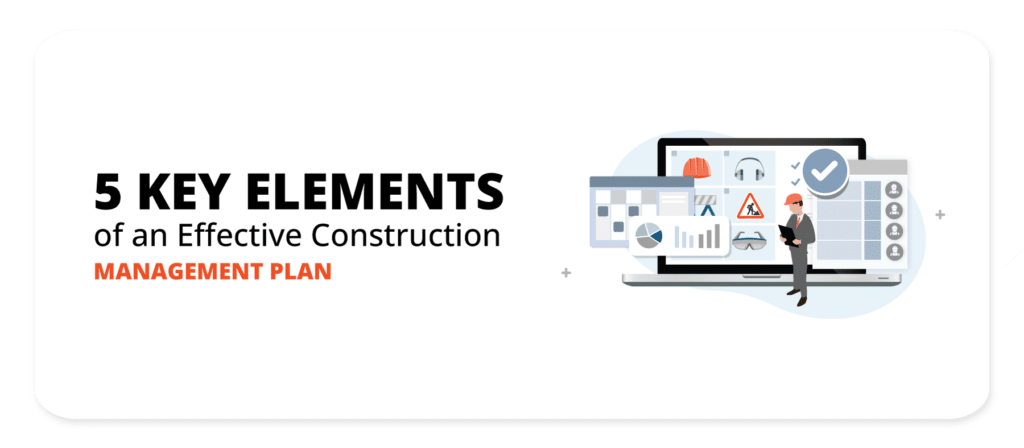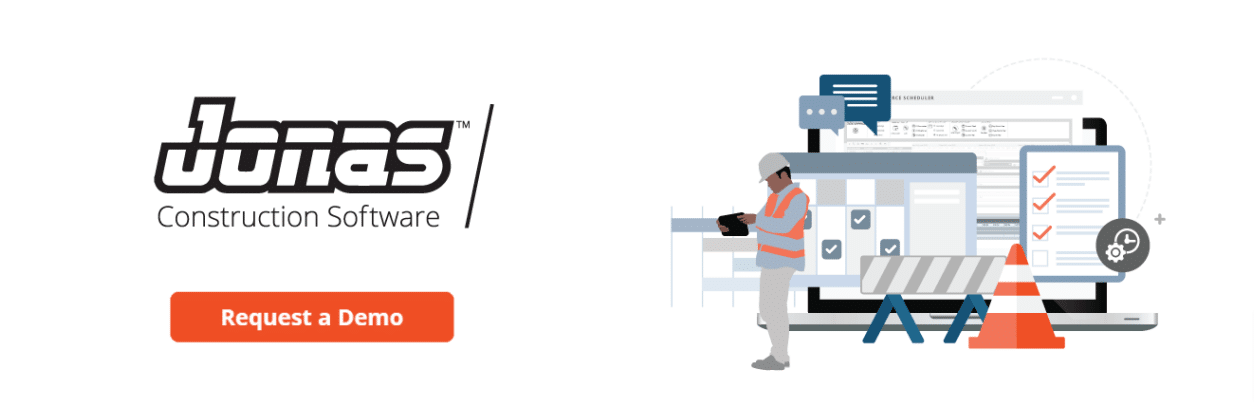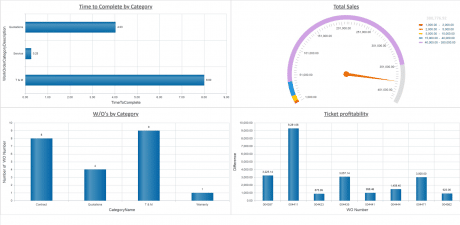Last Updated on October 17, 2023

Construction management plans are the glue that keeps construction projects together. Construction projects are prone to unique challenges, including fluctuating material costs, labor shortages, and safety concerns. They involve coordination among many different moving parts, such as procurement and management of materials, team coordination, safety management, and client communication. This means that projects can easily become derailed if a solid construction management plan is not in place, which can lead to delays, cost overruns, and profit squeeze.
In this blog, we’re breaking down what a construction management plan is and the key elements that you should include in your construction management plans to set your projects up for success.
What Is A Construction Management Plan?
A construction management plan (CMP) is a comprehensive document that details all the information needed to complete complex construction projects on time and within budget. This may include information like task schedules, costs, and resources to facilitate project completion and to set clear guidelines for how project work should be managed.
The CMP is typically prepared by project managers, construction managers or sometimes the lead consultants. With clearly defined objectives and key milestones, a CMP ensures that all efforts are directed toward achieving the project goals by aligning the expectations of stakeholders, including owners, contractors, suppliers, and regulatory authorities. This plan is also a useful resource for determining whether a project is feasible and aligns with customer requirements.
Building a clear construction management plan that is closely aligned with your project objectives will give you a solid foundation and pathway to follow. This will reduce your chances of unexpected project hiccups (although these are sometimes unavoidable even with the most solid plans) and prepare you to appropriately tackle any challenges that are thrown your way.
Key Elements of an Effective Construction Management Plan
So, now that you know the importance of a strong construction management plan, what do you need to include in your plan? We’ll cover five essential elements of an effective construction management plan in the following sections.
1. A Clearly Defined Project Scope
The best way to approach construction plans is to start with the end in mind! What exactly are you trying to accomplish with this project? What are the goals you would like to achieve? What’s the project scope and how will you know if your project is successful?
The project scope describes the overall activities, responsibilities and needs of a project. Although the goals and objectives of a project may seem obvious, different people can have very different ideas of what a “finished” project might look like. That’s why it’s important to take key stakeholders’ opinions into account to ensure you have their buy-in and everyone is on the same page.
When creating your project scope statement, it can be helpful to consider the following questions:
- Why does the project need to happen?
- What is within the scope of your project?
- What is not within the scope of your project?
- What do you hope to achieve with this project?
- What could adversely affect project progress?
- What are the business benefits of this project?
2. A Project Schedule
After everyone is on the same page about the project scope, you can begin to develop a project schedule. Project schedules are often confused with project plans and are just one of the many aspects that your construction management plan should include. A project plan is a holistic roadmap that details what, why, when, how, and who of the entire project. Whereas, a project schedule primarily addresses the ‘when’ and the ‘how’ within the broader context of a Project Plan.
To be precise, Project scheduling is an estimation of how long it will take to complete each task, the entire project’s duration, important deadlines and milestones, and the order in which tasks should be completed. Don’t forget to leave some extra wiggle room. There are many things that could delay a project task and if you don’t account for them, your entire project could become delayed.
Create a Roadmap
One of the ways you can format your project schedule is with a roadmap. This is a great tool to help you orchestrate the many different aspects of your project. Essentially, a roadmap is a visual timeline of your project schedule (like a Gantt chart) that shows the various aspects of your project together on one timeline.
3. Assigned Team Member Responsibilities
Once you know the exact set of activities that need to be done to complete a project, you can begin to plan who will be required to complete specific tasks. Coordinating the responsibilities of everyone involved, including stakeholders, will ensure everyone is clear on what they need to do. For example, an owner, engineer, architect auditor or project sponsor may be required to approve change orders throughout parts of your project. Ensure that you don’t leave these parties out when assigning tasks.
Create a Work Breakdown Structure (WBS)
Similar to the roadmap document we previously discussed, a work breakdown structure (WBS) will also help you visualize your project schedule. A WBS is specifically useful for visualizing project deliverables and organizing task assignments. The larger project is broken down into smaller sections, which allows you to easily assign the right task to the right person. One of the key benefits of these documents is that they help project managers ensure a uniform allocation of workload.
4. A Communication Plan
The next key element of an effective construction management plan is a communication plan. This should outline how, when, and how often you will communicate with the stakeholders involved in your project. The communication plan should also specify how and who to contact should an issue occur. This will ensure that any issues or roadblocks will be dealt with efficiently to avoid project delays.
Clearly documenting the collaboration channels before the project is put in motion will ensure that no one misses out on important project documents .
In addition, it’s a good idea to include the following information in your communication plan:
- The kinds of updates that stakeholders will receive.
- The reports that will be generated.
- The approvals that will be needed.
- The types of issues that should be escalated.
- The location where project information can be accessed (and who can access it)
5. A Risk Management Plan
So, you’ve done all the work putting together your construction management plan so far. But, now it’s time to accept that your plan… might not go as planned. Projects are bound to change once they’re actually up and running in real life, rather than just idealistic words on paper. Acceptance of the inevitability of these changes will help you prepare for, and mitigate them. Your risk management plan is where you plan for, and anticipate, those changes so they’ll be easier to manage when they inevitably occur.
Construction project risks can vary greatly — from public safety risks and physical risks for the people on the job site, to more mundane aspects of the project such as the risk of project costs going over your cost estimates.
Although the events detailed in your risk management plan may not occur, it’s always better safe than sorry. Detail every risk that your project may pose, how these risks can be mitigated, and a plan of action for how your team should respond if these events do occur during your project. The clearer your specifications, the better.
An effective construction management plan should include a thorough risk management section with detailed information to prepare your project team for anything and everything and maximize the success of your project.
Jonas Construction Software Helps Keep Your Projects on Track
Now that you’ve understood how to create a comprehensive construction management plan, let us help you put your plan into action to manage the project successfully. Construction Management Software is one of the best investments you can make to keep your construction project in check and simplify your project management processes. Jonas offers construction management software solutions integrated with accounting, payroll and field operations to automate and streamline project processes. This effectively expedites timelines and eliminates opportunities for human error to produce more accurate, timely data.
With Jonas, project managers can keep better track of technician and equipment utilization and profitability during the construction process. Project managers can also take advantage of our integrated document management system and reporting and business intelligence functionality for better visibility into project costs and operations.
SPEAK WITH AN ACCOUNT REP today or REQUEST A DEMO to see how Jonas Construction Software can help you plan and execute successful construction projects.







